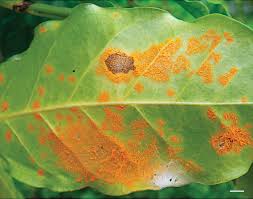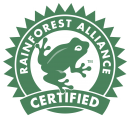Hemileia vastatrix – Coffee Rust
 Where there is coffee, there is ‘coffee rust’. But the long stalemate between growers and the fungus behind the devastating disease has broken — with the fungus taking the advantage. As one of the most severe outbreaks ever rages through Central America, researchers are reaching for the latest tools in an effort to combat the pest, from sequencing its genome to cross-breeding coffee plants with resistant strains.
Where there is coffee, there is ‘coffee rust’. But the long stalemate between growers and the fungus behind the devastating disease has broken — with the fungus taking the advantage. As one of the most severe outbreaks ever rages through Central America, researchers are reaching for the latest tools in an effort to combat the pest, from sequencing its genome to cross-breeding coffee plants with resistant strains.
The fungus first emerged as a significant problem by 1869 in Ceylon — now Sri Lanka — before spreading around the world. Stuart McCook, a historian at the University of Guelph in Canada who studies the rust, says that the wet weather in some areas of Ceylon was ideal for the spread of the fungus, and more than 90% of coffee crops were wiped out in those regions. Faced with an economic catastrophe, the country abandoned coffee for the tea it is associated with today. The disease is so universal that it “is not going to be eradicated; or the only way to eradicate the disease in practice is to eradicate all of the coffee”, says McCook
In our recent conversations and meetings with farmers and Coop owners from Costa Rica we learned that the Institute of Coffee of Costa Rica estimates that the latest outbreak may halve the 2013–14 harvest in the worst affected areas of the nation. This outbreak is “the worst we’ve seen in Central America and Mexico since the rust arrived” in the region more than 40 years ago, said Ricardo Hernández of the Coope Tarrazú. The farmers in Costa Rica are now using twice the amount of fungicide to fight the disease which is increasing their production cost. It appears that La Roya as the rust is known in Spanish has become resistant to the old fungicide! There are reports of devastations in Nicaragua and El Salvador. Costa Rica has enacted emergency legislation to speed up the flow of government money towards fighting the fungus. Other nations are also stepping up the fight. The Nicaraguan government has reportedly declared that it would include coffee rust on a list of special research projects designed to safeguard the country’s agriculture.
The solution seems to be the development of resistant strains in coffee. Colombia could be the closest to a solution. Marco Aurelio Cristancho, a researcher at Cenicafé, the National Centre for the Investigation of Coffee in Chinchiná, says that the government has supported research into developing resistant strains of coffee through crossbreeding. The introduction of resistant strains, together with improved weather monitoring to help predict rust outbreaks, has meant that fewer than 10% of plants now need to be treated with fungicide, down from 60% four years ago, Cristancho says. The government has also supported work on the genetics of both the fungus and the plant.
Research programmes have started in other countries, like the Federal Rural University of Rio de Janeiro in Brazil, is working to isolate resistance genes in coffee and to find molecular markers that distinguish between different strains of the pathogen and that could be used to develop tailored strategies for its control. In Nairobi, a not-for-profit development organization CABI is using money from the intergovernmental agency the Common Fund for Commodities, as well as from Kenya, India, Rwanda, Uganda and Zimbabwe, to screen for resistant coffee plants and to analyse varieties of the pathogen. Governments in coffee-growing countries need to take coffee research as a priority and provide necessary resources in order to keep rust disease at bay.
Source: http://www.nature.com/ Wikipedia – The Free Encyclopedia








